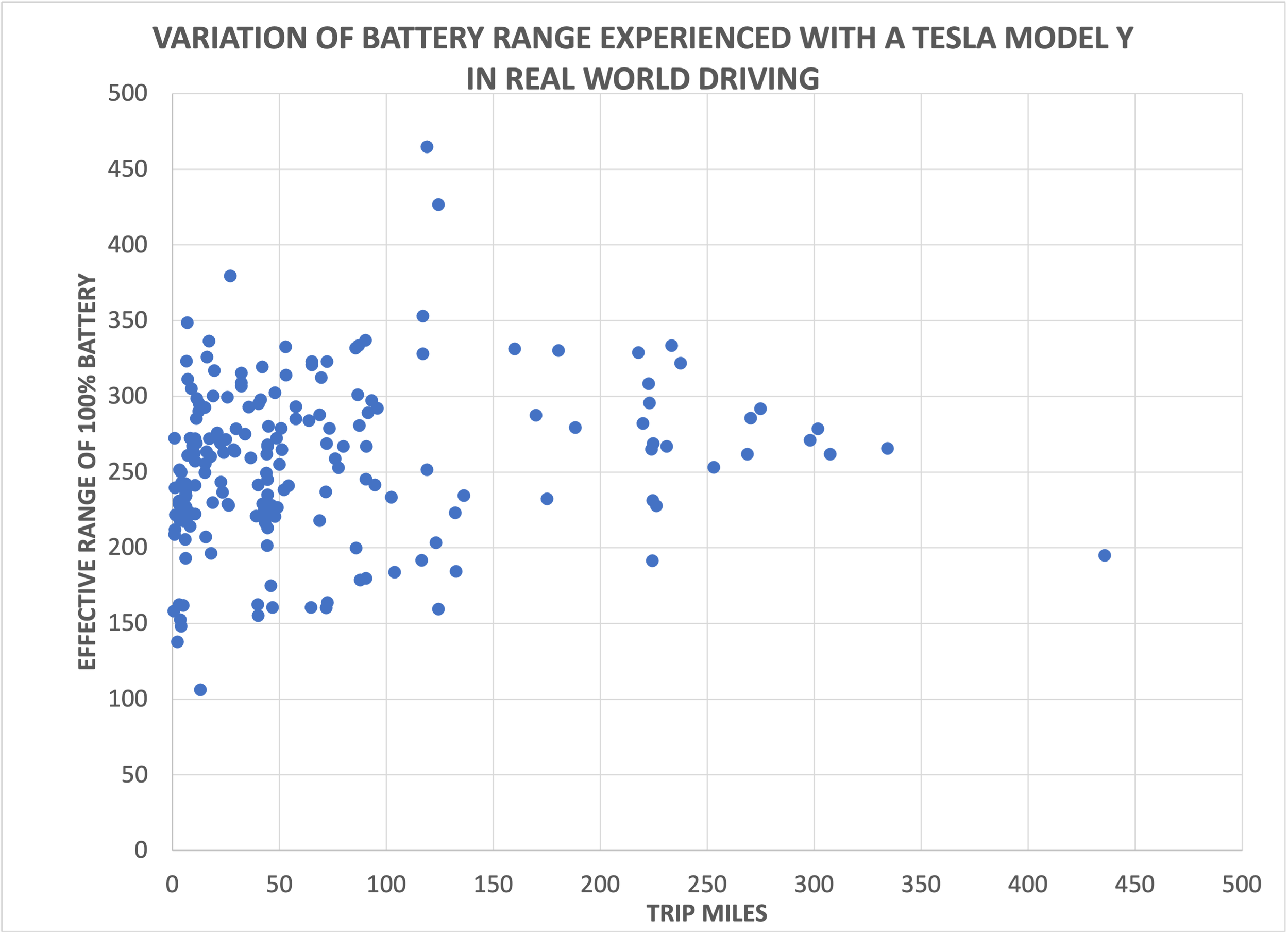Your actual EV range will vary significantly
In real world driving, EV range varies much more significantly than conventional vehicles. This can be problematic for car owners and fleets with longer trips
There needs to be more consideration of the significant variation in range with EVs, as we look to expand EV car and fleet deployments. For many, the variation in range will be manageable as their trip mileage is less than the minimum range from the fully charged battery. However, for some, the range variation can become a nasty surprise requiring careful planning for longer car road trips and fleet routes. This is not a barrier for EVs, but is another aspect the EV vehicle buying world will need to understand.
How variable is the range
With EVs now having rated range of 200-300+ miles, our EV range anxiety is likely to shift to be about the significant variation of this range in real world driving rather than the rated range of the vehicle. I enjoy having my Tesla model Y, but its range has varied anywhere from its EPA rated 330 miles down to just over 100 miles. My effective range during trips is shown in the chart below:
The variation in EV range (or EV efficiency in kWh/mile) has also been observed in recent fleet demonstrations too. Heavy duty fleets have found energy usage varying between 2 - 3 kWh/mile. This leads to trucks being deployed on shorter routes, or requiring additional charge during the day, which takes up operational time and can be expensive with electricity cost being charged at peak rate.
The range variation depends on factors such as cargo load, wind direction, ambient temperature, driving speed, route hilliness, and present difficulties in predicting range for a given route on a given day. Although prediction software like Tesla’s energy app and EV fleet management software are now accounting for more of these factors. My most anxious experience was on a road trip where there was 120 miles between available superchargers, and my effective range that day was 160 miles assuming a full battery. The navigation software predicted I only needed 70% state of battery charge and I thought I was being conservative leaving the first supercharger with 80%. I ended up limiting driving speed to make sure I reached the next supercharger !
We are not used to such a range variation with our fossil fueled vehicles, since for those, the engine efficiency increases with engine load, and this minimizes the impact of speed, grade, cargo and wind on range variation. Whereas, EV powertrains will have decreasing efficiency with vehicle load. Hence the level of range variability can be quite a surprise.
Implications of range variability
For cars driving around cities, the range variation is not really an issue, since trips are much less than the battery range and the cars can be recharged once the owner is home or parked at a mall etc. However, road trips needed to be carefully planned and the feasibility of the trip is dependent on sufficient (working and available) fast chargers enroute. There is also the added challenge that the range of the EV battery decreases with usage. Fortunately, this decrease is relatively slow, but it does mean that as vehicles age they may no longer be able to make some road trips unless more fast chargers become available.
For fleets, the range variability has wider implications. Each route needs to be planned as to whether it can be supported by the specific EVs in the fleet. Longer routes may not be suitable for EVs, or at least older EVs. Fleet management software is available, but adds yet another expertise the fleet has to learn as it moves to electrification. Not necessarily a problem in the longer term as experience with EVs increases, but there is a risk of short term problems arising resulting in disappointment with EV performance.
Of course range variability could be overcome by further increasing battery sizes such that the minimum range is more than sufficient for the routes. We are already seeing this with Transit Bus EVs now moving to 600+ kWh batteries rather than around 400 kWh. However, larger batteries add cost and weight. The weight additions can lead to payload restrictions and will add to tire and break wear. Apart from the additional maintenance cost, this will likely add to the tire and brake dust particles polluting our air (these are now the greatest source of particulate emissions from our vehicles). Another solution is to add more fast charging infrastructure to extend the daily miles achievable with a certain battery pack. But this solution puts more demand on the grid and fast charging does tend to reduce battery life.
The other solution is a more extensive network of fast charging stations. This will require more infrastructure planning and investment, and unfortunately, we are already experiencing maintenance issues with existing stations. Another challenge is the more fast charging stations we have and use, the increased power demand on the grid. These short term, unscheduled load spikes are challenging to manage and likely to need stationary energy storage to peak shave.
This is not intended to be an anti-EV viewpoint – far from it. For many applications, e.g city driving in cars, fleets with fixed routes, the range variability is not an issue or can be easily managed. For these applications, EV are clearly well suited. However for longer daily drives, especially for fleets with dynamic routes, more planning and consideration is required. Its possible that EV is not always the best solution for these applications, but thats a different discussion point (for example, read the next article on hydrogen). My main point is that range variability needs to be better understood so we can manage and plan around it, especially with the interest and desire to scale up EV sales.

